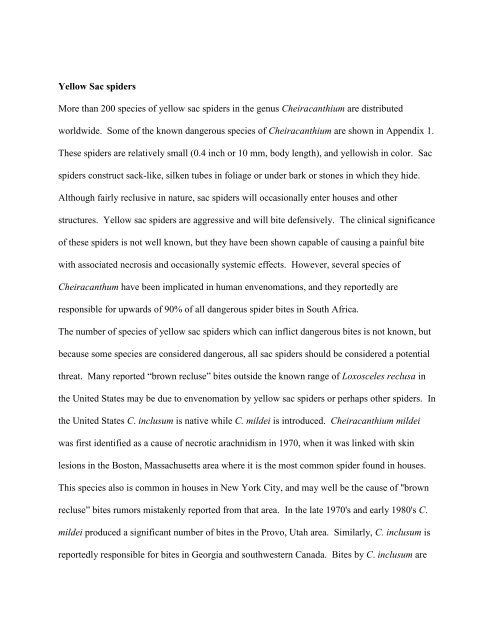Field Guide to Venomous and Medically Important Invertebrates ...
Field Guide to Venomous and Medically Important Invertebrates ...
Field Guide to Venomous and Medically Important Invertebrates ...
Create successful ePaper yourself
Turn your PDF publications into a flip-book with our unique Google optimized e-Paper software.
Yellow Sac spiders<br />
More than 200 species of yellow sac spiders in the genus Cheiracanthium are distributed<br />
worldwide. Some of the known dangerous species of Cheiracanthium are shown in Appendix 1.<br />
These spiders are relatively small (0.4 inch or 10 mm, body length), <strong>and</strong> yellowish in color. Sac<br />
spiders construct sack-like, silken tubes in foliage or under bark or s<strong>to</strong>nes in which they hide.<br />
Although fairly reclusive in nature, sac spiders will occasionally enter houses <strong>and</strong> other<br />
structures. Yellow sac spiders are aggressive <strong>and</strong> will bite defensively. The clinical significance<br />
of these spiders is not well known, but they have been shown capable of causing a painful bite<br />
with associated necrosis <strong>and</strong> occasionally systemic effects. However, several species of<br />
Cheiracanthum have been implicated in human envenomations, <strong>and</strong> they reportedly are<br />
responsible for upwards of 90% of all dangerous spider bites in South Africa.<br />
The number of species of yellow sac spiders which can inflict dangerous bites is not known, but<br />
because some species are considered dangerous, all sac spiders should be considered a potential<br />
threat. Many reported ―brown recluse‖ bites outside the known range of Loxosceles reclusa in<br />
the United States may be due <strong>to</strong> envenomation by yellow sac spiders or perhaps other spiders. In<br />
the United States C. inclusum is native while C. mildei is introduced. Cheiracanthium mildei<br />
was first identified as a cause of necrotic arachnidism in 1970, when it was linked with skin<br />
lesions in the Bos<strong>to</strong>n, Massachusetts area where it is the most common spider found in houses.<br />
This species also is common in houses in New York City, <strong>and</strong> may well be the cause of "brown<br />
recluse‖ bites rumors mistakenly reported from that area. In the late 1970's <strong>and</strong> early 1980's C.<br />
mildei produced a significant number of bites in the Provo, Utah area. Similarly, C. inclusum is<br />
reportedly responsible for bites in Georgia <strong>and</strong> southwestern Canada. Bites by C. inclusum are

















